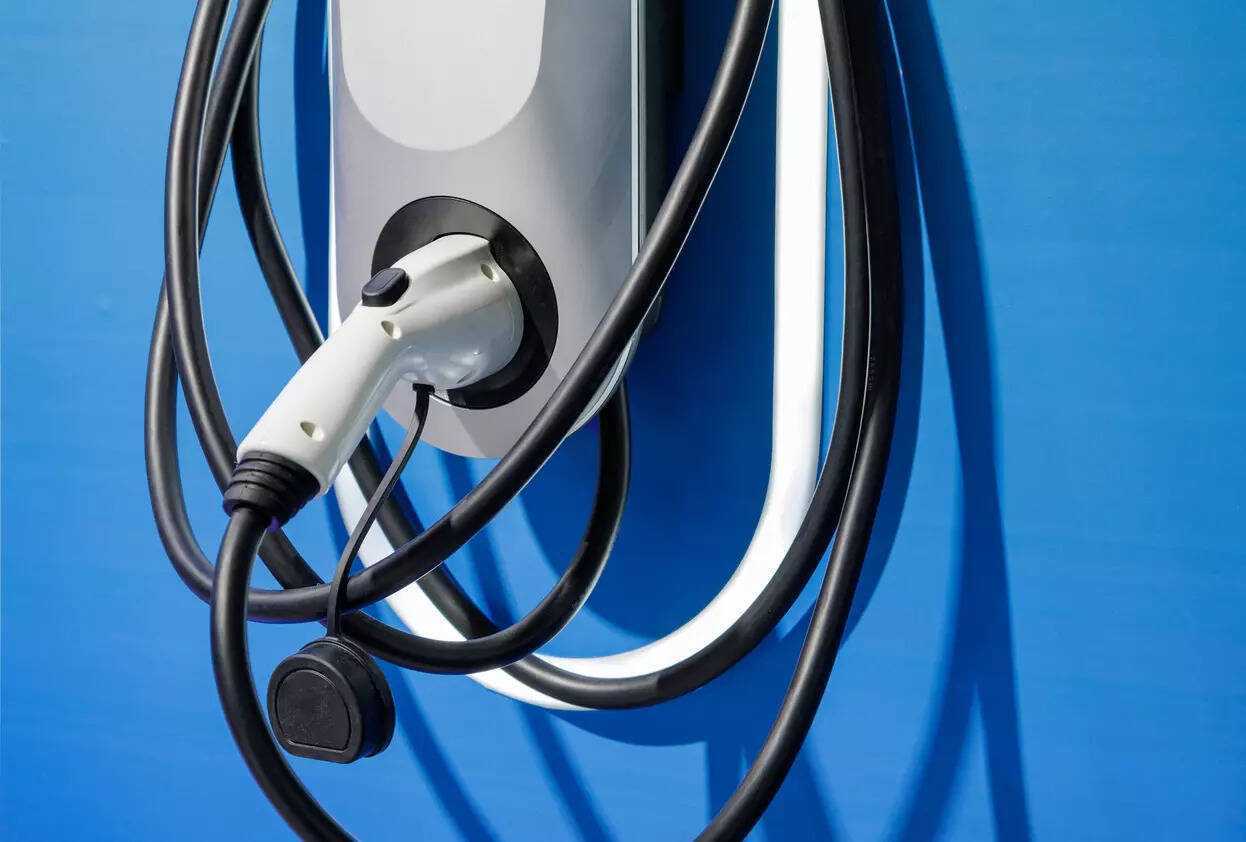Another challenge is the shortage of trained technicians and availability of OEM-certified spare parts, especially in Tier 2 and 3 cities. Most stations lack smart diagnostics to detect connector faults proactively, meaning issues often go unnoticed until they cause real disruption.
 Jasti recommends implementing AMC (Annual Maintenance Contract) policies that include connector servicing, alongside development and enforcement of BIS-compliant service protocols. “
Jasti recommends implementing AMC (Annual Maintenance Contract) policies that include connector servicing, alongside development and enforcement of BIS-compliant service protocols. ““>
As India’s electric vehicle (EV) ecosystem expands at a rapid pace, the focus remains firmly on scaling infrastructure and boosting adoption. However, a critical yet largely ignored component is the EV charging gun—central to vehicle charging but often sidelined when it comes to maintenance and service protocols.Despite their critical role in the charging process, charging guns are plagued by a lack of timely upkeep and the absence of standardised service protocols. In India, they endure not just extreme weather conditions, ranging from intense heat, dust storms to monsoon humidity, but also face rough handling, vandalism, and a shortage of trained technical personnel with necessary technology know-how.
Fragmentation in Connector Types Worsening the Challenge
Experts point out that the use of non-standard, proprietary connectors by some manufacturers is further fragmenting the charging ecosystem. This complicates serviceability for operators who must navigate multiple charging gun designs, limited spare part availability, and inconsistent knowledge levels.“For India’s EV ecosystem to scale sustainably, awareness around charging gun maintenance and timely servicing needs to become a shared priority across buyers, sellers, and infrastructure stakeholders,” says Arun Handa, Chief Technical Officer, Servotech Renewable Power System Ltd. He stresses that many users still wrongly assume chargers are maintenance-free. “That’s why it is important to educate users through social media and onsite campaigns to create user-side awareness and prevent misuse, rough handling, and promote user-driven reporting of faults. An unserved charging gun can be directly compared to a virus that can immediately affect any EV it comes in contact with.”

Multiple Risks, One Solution: Preventive Maintenance
“A poorly maintained charging gun poses multiple risks such as thermal damage, safety hazards, vehicle damage, poor user experience and regulatory non-compliance,” explains Krishna K Jasti, CEO & CPO, EVRE. Jasti recommends implementing AMC (Annual Maintenance Contract) policies that include connector servicing, alongside development and enforcement of BIS-compliant service protocols. “Mandatory real-time fault monitoring and alerts for connector faults, training field service staff in connector repair and inspection, and providing incentives or GST relief for certified connector replacement parts could be game-changers. Encouraging local manufacturing of reliable, India-ready charging guns is also crucial.”He further adds, “Many charging stations are installed outdoors, exposing guns to dust, rain, and extreme temperatures, accelerating wear and tear. Moreover, limited awareness among operators and consumers about periodic servicing needs, and supply chain delays for connector replacements or spare parts, especially for imported components pose serious concerns.” Emphasizing that continuous monitoring of multiple parameters is essential for the efficient functioning of an EV, Sanjeev Kulkarni, CEO, BillionE, says, “Beyond speed, it’s critical to track the State-of-Charge (SOC) profile, cell and battery temperatures, user behaviour patterns, and instances of isolation resistance loss.” He also highlights the crucial role that proper maintenance of charging guns and sockets plays in ensuring the safety and performance of both EVs and the supporting infrastructure. “We are dealing with high current flow, so it’s imperative to have a routine mechanism in place for cleaning and maintaining charging guns,” he adds.
A Complex Ecosystem of Charging Guns with Varied Connector Types
Currently, the EV charging stations in India are equipped with different charging gun technologies with origins from India, Europe, China and Japan. These range from Bharat AC-001 to Type 2 guns (IEC 62196-2) AC chargers used to charge 2,3, and 4-wheelers, Type 6 and 7 guns for DC chargers used for charging 2 wheelers (these chargers can also work with 3-wheelers as the technology evolves). LECCS (Light Electric Combined Charging System) – part of the IS17017 (Part 2 / Sec 7): 2023 standard, enable both AC and DC charging through a single interface. “Is a connector developed by Ather Energy and has shared this connector design with other manufacturers to encourage interoperability and broader adoption,” shares Jasti.
“Currently, many 2W and 3W manufacturers still rely on non-standard, proprietary connectors, leading to fragmentation in the charging infrastructure. However, the industry is gradually moving towards the BIS-approved Type 6 DC connector, especially for fleet operations and battery swapping applications. This connector is specifically designed for low-voltage, fast-charging scenarios suitable for India’s light electric vehicle segment,” highlights Zoeb Karampurwala, Chief Product Officer, EKA Mobility.
CCS-2 guns (Combined Charging System)/ IEC 62196-3) DC chargers for 4-wheelers, and HEVs, these are an extension of the IEC 62196 Type 2 connector with two additional DC pins for high-power charging. This connector is used in most fast chargers in India and supports up to 360 kW, charging 4-wheelers, buses, and trucks within an hour.
“In fleet depots or dedicated hubs, vehicles often integrate with customised high-capacity chargers based on the CCS-2 protocol to facilitate efficient overnight or opportunity charging cycles,” explains Karampurwala.
He further shares, “For electric passenger vehicles, CCS-2 has become the accepted standard for DC fast charging, adopted by all major OEMs in India. For home and workplace charging, Type 2 AC connectors are standard, offering slow to moderate charging via wall-box units or public AC stations. This dual approach ensures both convenience and high-speed charging capabilities for users.”
Maintenance equals Reliability
Routine inspection and cleaning of the pins, especially in CCS-2 connectors, which support high-power DC flow, is a necessity. “Any dirt or corrosion on the contact points can disrupt communication between the charger and the EV, resulting in failed sessions or battery damage,” says Handa. Frequent plugging and unplugging of charging guns also lead to mechanical wear. Without timely intervention, connectors may overheat or melt, posing serious safety risks for both the station and users.
Another challenge is the shortage of trained technicians and availability of OEM-certified spare parts, especially in Tier 2 and 3 cities. Most stations lack smart diagnostics to detect connector faults proactively, meaning issues often go unnoticed until they cause real disruption. “To build a reliable charging infrastructure, India must prioritise preventive servicing of Type 2 and CCS-2 connectors and create localised technical support systems,” says Handa.
Road Towards Standardisation
Meanwhile, GB/T guns are used in older 4-wheeler EVs. These guns are Chinese DC fast charging standard, used for 3-wheelers and 4-wheelers in early deployments. “Currently, no major EV manufacturer in India supports GB/T, and it is being phased out,” shares Jasti.
“The Indian EV ecosystem is now steadily moving toward universal CCS-2 adoption, which will gradually phase out GB/T chargers. This shift is expected to eliminate the widespread issue of GB/T to CCS converter dependency, streamlining charging infrastructure, and enhancing user convenience,” adds Handa.
CHAdeMO, a Japanese DC fast charging standard used by a few Japanese-origin EVs like the Nissan Leaf, has been less prevalent in India due to limited vehicle compatibility and minimal OEM adoption. The initial set of chargers deployed had both CHAdeMO and CCS-2 connectors.
Infrastructure Still Catching Up
“The charging infrastructure ecosystem for electric vehicles in India is currently at a nascent stage,” says Rohan Kanwar Gupta, Vice President & Sector Head, Corporate Ratings, ICRA Limited. “There are only ~25,000 charging stations, even as the number has improved significantly from about 1,800 – 2,000 public charging stations in 2021.”
Lack of adequate charging infrastructure has been a key deterrent for EV penetration in India. Apart from capability development and driving demand, the government has, therefore, focused on improving the charging infrastructure across the country to help address range anxiety concerns related to EVs, including allocation for the same in the PM E-Drive Scheme. There has been material traction seen in investments from both PSU and private players in the EV charging space. “Despite the anticipated sharp increase in EV charging stations, the number could remain significantly low (vis-a-vis the requirement) and constraint EV penetration over the near to medium term,” says Gupta.
India’s EV charging ecosystem is expanding fast, however, unless critical components like charging guns are prioritised with standard protocols, skilled maintenance, and user education, the infrastructure may fail to keep pace with adoption. A reliable, safe, and interoperable charging experience begins with treating the humble connector as the heart of the system—not its afterthought.
“By combining awareness, training, digital tools and policy support, India can improve the reliability and safety of EV charging infrastructure and support widespread EV adoption,” says Jasti.
Join the community of 2M+ industry professionals.
Subscribe to Newsletter to get latest insights & analysis in your inbox.
All about ETAuto industry right on your smartphone!
- Download the ETAuto App and get the Realtime updates and Save your favourite articles.




